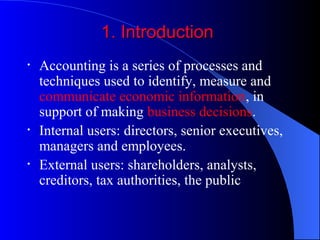Accounting provides economic information to support business decisions. The three main financial statements are the income statement, balance sheet, and cash flow statement. The balance sheet presents assets, liabilities, and owner's equity on a given date to show the resources and how they are financed. Key assets include fixed assets, current assets, and inventory. The income statement matches revenues and expenses over a period to determine profit or loss.













































































































![Variances, materialsVariances, materials
• Material efficiency variance: [std quantity used –
actual quantity] x std price per unit
• Material price variance: [std unit price – actual
unit price] x actual quantity used (or purchased)
• Process may consume less of a higher quality (and
usually higher price) material; or more of a lower
quality (and usually lower price) material. This
can also directly affect the amounts of labor or
variable overheads required.](https://image.slidesharecdn.com/vinoliasacctgslide-160509172134/85/acctg-MBA-slide-110-320.jpg)
![Variances, laborVariances, labor
• Labor efficiency variance: [std time allowed
– actual time taken] x std rate
• Labor rate variance: [std rate per hour –
actual rate] x actual time taken
• Labor may be more or less skilled; aided or
hampered by materials, equipment; become
more expensive with overtime/ downtime](https://image.slidesharecdn.com/vinoliasacctgslide-160509172134/85/acctg-MBA-slide-111-320.jpg)
![Variances, variable overheadVariances, variable overhead
• Efficiency variance = [std cost of flexible
budget time for units produced] – [std cost
of actual time taken for units produced]
• Spending variance = [std cost of actual time
taken for units produced] – actual costs
incurred](https://image.slidesharecdn.com/vinoliasacctgslide-160509172134/85/acctg-MBA-slide-112-320.jpg)





























